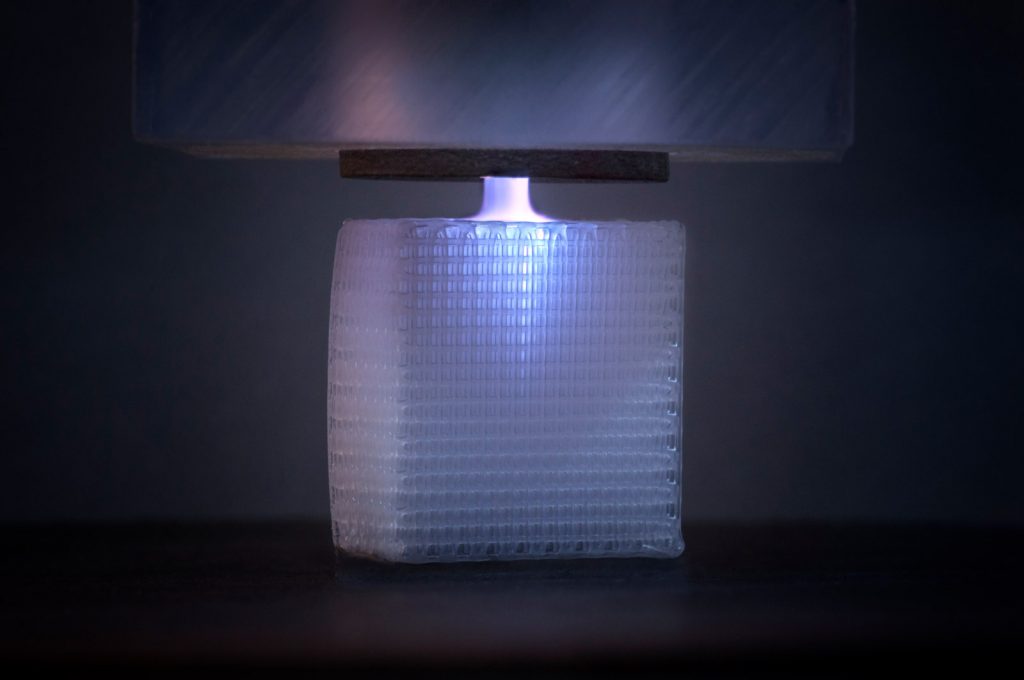Researchers at the Fraunhofer Institute for Surface Engineering and Thin Films IST have developed a technique that involves 3D printing bone implants that are precisely fitting, stable and variable in dimensions. Conventional surface treatments that use low pressure or atmospheric pressure techniques have limited penetration into the interior of bone implants, but Fraunhofer’s technique uses a plasma jet to apply a cell growth-promoting coating to the interior as well as the exterior of the implants.
 The device blows a cold jet of plasma containing reactive groups directly onto the 3D printed layers. The amino groups then bond with the surface and ensure that the bone cells find a convenient substrate to adhere to. The technique differs from others in that the 3D printing and coating processes are combined in one device. No chemical pretreatment with solvents is required for the coating, so the procedure is both cost-effective and environmentally friendly.
The device blows a cold jet of plasma containing reactive groups directly onto the 3D printed layers. The amino groups then bond with the surface and ensure that the bone cells find a convenient substrate to adhere to. The technique differs from others in that the 3D printing and coating processes are combined in one device. No chemical pretreatment with solvents is required for the coating, so the procedure is both cost-effective and environmentally friendly.
The implant is built around a scaffold made from a special copolymer that is molded on the natural bone. The technique allows for customized, patient-specific, precisely fitting design and stability.
“Our goal is for the bone cells to grow into the synthetic structure as quickly as possible and finally replacing the implant which is broken down gradually by the body’s own enzymes,” said Dr. Jochen Borris, who heads up the Life Science and Ecology business unit at Fraunhofer IST.
The mechanical stability of the implant can be controlled by the density of the 3D printed scaffold structure, as well as via special fillers that are added to the copolymer. The higher the filler concentration, the more stable the implant will be.
“This development by our project partners from Maastricht University makes it possible to individually vary the stability inside the implant. Like natural bones, implants can now have areas with different strengths,” said Dr. Thomas Neubert, manager of the EU project at Fraunhofer IST.
 Active drug ingredients such as antibiotics can also be incorporated in the filler to reduce the risk of infection.
Active drug ingredients such as antibiotics can also be incorporated in the filler to reduce the risk of infection.
The next step for the project team is to modify the technique and bring it to application maturity. The experimental setup is still currently on a laboratory scale.
“We’re currently working on simplifying the process and making it more stable. To be able to further pursue development and carry out clinical studies, we’re on the search for industrial partners,” said Dr. Borris. “The innovative technique offers a lot of potential for adapting bone implants very precisely to the individual needs of patients. With our method, we’re able to control the shape, porosity, mechanical stability and biomechanical characteristics well and vary them within the implants. This means that we can produce areas with different strengths or porosities, which can also be coated with various functional groups.”
This technique has a lot of potential for the treatment of patients with cancer or severe fractures. In the future, the idea is for doctors to be able to formulate the specific requirements for each patient based on scanned images and then to send the data to medical print shops, which would 3D print the patient-specific implants.
Discuss this and other 3D printing topics at 3DPrintBoard.com or share your thoughts below.
Subscribe to Our Email Newsletter
Stay up-to-date on all the latest news from the 3D printing industry and receive information and offers from third party vendors.
You May Also Like
Precision at the Microscale: UK Researchers Advance Medical Devices with BMF’s 3D Printing Tech
University of Nottingham researchers are using Boston Micro Fabrication‘s (BMF) 3D printing technology to develop medical devices that improve compatibility with human tissue. Funded by a UK grant, this project...
3D Printing Webinar and Event Roundup: April 21, 2024
It’s another busy week of webinars and events, starting with Hannover Messe in Germany and continuing with Metalcasting Congress, Chinaplas, TechBlick’s Innovation Festival, and more. Stratasys continues its advanced training...
3D Printing Webinar and Event Roundup: March 17, 2024
It’s another busy week of webinars and events, including SALMED 2024 and AM Forum in Berlin. Stratasys continues its in-person training and is offering two webinars, ASTM is holding a...
3D Printed Micro Antenna is 15% Smaller and 6X Lighter
Horizon Microtechnologies has achieved success in creating a high-frequency D-Band horn antenna through micro 3D printing. However, this achievement did not rely solely on 3D printing; it involved a combination...






























